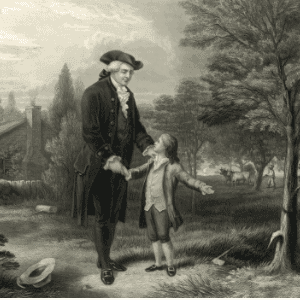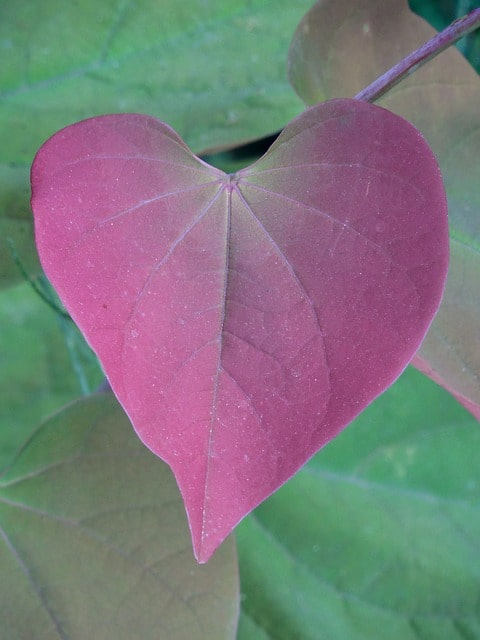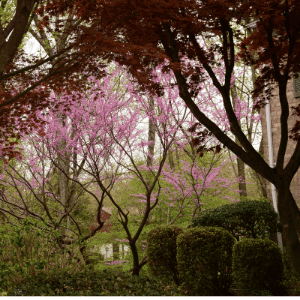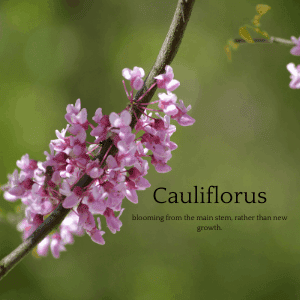George Washington Loved This Tree–Cercis canadensis
The Eastern Redbud tree is an American Classic and a native also. It is a flowering tree in the family Fabaceae, which means it is related to beans, peas, and other legumes. (Yes, people do eat the blossoms.) Native trees are easy to grow and benefit our environment too.
A very early bloomer it is valued by pollinators of all kinds because it provides pollen and nectar early in the spring before other sources are available; the redbud says springtime to all of us, large and small.
The Flowering Redbud: A Symbol of America’s Springtime!
The Redbud symbolizes America’s springtime! We love our spring-blooming trees, the ones that say, “winter will finally end.” This tree, the Eastern or American Redbud, is a North American native, and as such, it is uniquely ours. George Washington dug young wild redbud trees from the woods and added them to his “shrubbery.” He kept good records, and we know today how he used the redbud.
Is It Eastern or American Redbud?
The titles are used interchangeably, and both are botanically named Cercis canadensis. They are the same tree!
The Importance of Plant Identification
A lifelong gardener I finally found the time to become trained as a volunteer Master Gardener. My husband and I took the course together and volunteer in our South West Florida community. In the training, which comes from each state’s Land Grant university, we make a big point of learning accurate plant identification.
I am a believer in plant identification. If you can properly identify your plant you have the best chance of growing it successfully. For accuracy, then, I prefer the term Eastern Redbud because it makes identifying other redbud varieties so much easier!
To help gardeners in my communities (where I live and online I present an introduction to Botanica Latin. If you get the name right, you can find all the other information.
Latin for Gardeners: how to read and remember plant names.
The various redbuds are all beautiful, early blooming ornamental trees. But the different varieties suit different climates. Planting a tree is a big commitment. I would like every gardener to have the best chance to get it right!
Why A Redbud In A Shrubbery?
What’s a “shrubbery”? Think of a shady place for sheltered walks. On a fine day, you want to walk and think, a little chat, admiring the plantings. On a blustery day, you need to get out too. This is where you go. That’s what ‘a shrubbery’ is for. (If you think you remember shrubberies featuring in Jane Austen’s novels, you’re right!)
In Pride and Prejudice, if you remember, Elizabeth Bennet spoke her mind to a meddling busybody while walking in the shrubbery. Did George do the same?
George and His Trees

We all know about George and trees! He loved them and he planted lots of them; trees to feed the family and trees to enjoy looking at. The redbud did both. Magenta-colored buds, fading to bold pink-purple flowers. The buds are tasty in salads and make a beautiful jelly.
The tree wood is hard and good for turning. The bark is full of tannin and has been historically used for medicine. In simpler times the redbud was far more than ornamental!
(This photo is from one of the free photography sites and is from an 1867 lithograph made from a painting by G.G.Whiter.)
Why Americans Love The Redbud In Springtime
How we all loved our redbud trees, Jefferson loved them too. In fact, I see that Monticello will sell you young redbud trees online. They are small and inexpensive but it is a young blooming tree and you can own a little bit of history, I have been to Monticello but have not bought from their shop. Here’s a link. If you plant one send me a note.
Early Spanish settlers noticed that the redbud they found here was a lot like one they knew in the Mediterranean. Also. it is the state tree of Oklahoma. Its popularity stems from its beauty and the fact that it is widespread in North America.
It is found in woods and backyards from Ontario (note the name “canadensis”) to north Florida. There is a California relative, a little smaller. It is an early bloomer too, which makes people look forward to it. The redbud does not have a really long lifespan but within that time it leads a low maintenance life.
The Redbud Tree American or Eastern Redbud?
Other Redbud Varieties

I emphasize the Eastern Redbud tree because it is so hugely popular throughout North America. You will also see it called the American Redbud tree. It is the same tree, that Washington and Jefferson loved!
Note the true heart-shaped leaf of the Eastern redbud. Western varieties have a more rounded leaf.
(Photo thanks to Rebecca Matthews @Pixabay)
10 Redbud Varieties-All Symbolizing Spring
There are 10 varieties of Redbud Trees in its genus Cercis. Of these 4 are predominant and they are worth a definition.
- The Chinese Redbud-Cercis chinesis. It grows to about 15 feet in N. America, a little shorter than the American native and with larger purplish flowers.
- The Western Redbud-Cercis occidentalis. A small tree, it is found in the hills of California. The flowers are showy, bright pink or magenta and the early leaves are pale green and of various colors in fall.
- The European Redbud, or Judas tree-Cercis siliquastrum. Native to the Mediterranean and southern Europe, it is a small tree with rosy pink flowers.
- The Eastern Redbud-Cercis canadensis. Find this one throughout the eastern US, Canada, Texas, and Oklahoma. Despite its eastern name, it is the state tree of Oklahoma.
The Weeping Redbud Tree-Is Your Space Small?
If you have a very small space to plant in but would love a showy and charming flowering tree, this type of redbud might be the one!
Here are two varieties of the weeping redbud to consider:
- Lavender Twist Redbud-this tree is a dwarf variety, reaching 5-15′ tall. It shows a contorted trunk and branches, a wide weeping habit and the small, pea-like flowers you have come to expect from the redbud tree. The foliage begins in a bright green colored heart shaped leaf. The foliage will turn yellow in early autumn. In winter the twisted branching creates interest.
- The Ruby Falls Redbud is very a small tree, only 6-8 feet tall. Its cascading branches will spread 5-6′. The spring blossoms are small and fuchsia in color with leaves that start out, rich shades of purple, then a burgundy color and green in summer followed by yellow in fall. With its interesting, twisted winter branches it will not bore you any time of the year!
Redbud Tree Care
How To Plant The Weeping Redbud Tree
Like its bigger cousin, it demands well-drained soil. The soil can be moist and amended with compost. Like the standard redbud tree, ensure that you select the location carefully, They do not appreciate being moved.
This small tree will grow only as tall as it is staked. Its irregular stem is normally staked to be 5-6′ when the nursery sells it to you. You can add a taller stake and it can reach 8′.
How To Prune The Weeping Redbud Tree
Prune during the dormant season and carefully. Take your time, start by removing anything, crossing, with disease or already dead. Prune back to a bud or branch. You can raise the canopy by removing one lower branch per year.
Our garden is in a hot climate where we carefully prune a weeping hibiscus. It is a slow process, look all around the tree before you cut. You can’t put it back!
- The Ruby Falls Variety is very small, ranging from 6′ to 8′ in height. The leaves begin spring in purple, then turn burgundy, followed by green. The blooms are pink-purple. With the variety of seasonal colors and twisted aspect in winter this tree will add interest all 12 months of the year in a small spot.
Where Are The Redbud Trees Native?
They are found in Southern Europe and Western Asia as well as North America. This discussion is about the very widespread Eastern Redbud. There are several other varieties.
How Can I Use The Redbud Tree
Lovely in groupings, they are also excellent lawn specimens and border trees. They are a superior transition tree at the edge of woodland. There is fall color as well as spring flowers. purple foliage. They have winter appeal, the shape is attractive; try them against a wall. Near a patio, they are a source of shade.
Brighten A Wooded Area
The redbud, like many flowering trees, is a natural understory tree and makes a light addition to wooded space. Here we view the shade trees then the redbud and a water view.

How To Choose A Redbud Tree
Redbud is a widespread and popular tree. This creates a tremendous variety of available cultivars. Buy local varieties. Plant what you know will grow in your local area. How to do that?
- Look around, which types do you see looking healthy?
- Visit your nearest botanical garden, if they grow them, ask which varieties work well for them
- Go to a local garden center or grower
- Contact your County Extension service, if redbuds do well in your area they probably have quality research ready for you
- Check online for published research from your state agricultural school
Planting Zones-Where To Plant The Redbud Tree
You will see these trees growing successfully in a very wide territory in zones 4-9. They will epitomize springtime wherever you are.
Size And Shape Of The Redbud Tree
Relatively small, the redbud ranges from 20′-30′ high. It is similar in width with a rounded shape and near-horizontal branches. It is deciduous and the leaves are nearly heart-shaped and are 3-5″ in length and width. Leaves emerge in a reddish color, turn green and yellow in the fall.
There are weeping varieties that are pretty, shorter, and narrower. If you want a redbud and need to plant in a smaller space they may be just what you want.
Some Redbud Varieties To Consider
Weeping Lavender Twist Redbud-Cercis canadensis cul. ‘Covey’
- A fast growing umbrella-shaped tree with lavender blooms, it is a dwarf variety growing from 5-15′ in height. Some of its broadly heart-shaped green leaves will pop up in purple!
Texas Redbud-Cercis canadensis var. Texensis
- Reaching 15-20,’ the Texas redbud is a small tree or multi-trunked shrub. With showy, rose-purple blooms it is more drought and heat tolerant than most redbuds. Is your spot dry? You will find the leaves to be more rounded, thicker, and glossy than those of other redbuds.
Oklahoma Redbud-Cercis reniformus cul. ‘Oklahoma’
- With a rounded crown and often multi trunks, it will grow 20-25 feet tall and has a showy pink-purple bloom.
Mexican Redbud-Cercis canadensis var. mexicana
- From 10-15′ in height, this rounded tree is ornamental in sun and partial shade with wine-colored blooms. This is one to consider if your location requires a higher level of drought tolerance than some other redbuds.
Forest Pansy Redbud-Cercis canadensis cul. ‘Forest Pansy”
- If foliage is what you need this might be the one! First the rosy pink flowers in spring, then burnished red-purple leaves, that turn orange, bronze, and purple in fall. Color stays a long time with this tree. It has an Award of Garden Merit from the RHS!
Hearts of Gold Redbud-Cercis canadensis cul. ‘Hearts of Gold”
- For a light and bright, gold-yellow foliage, this is the only one I can find. The large, heart-shaped leaves begin life in red and then turn to gold.
Tennessee Pink Redbud-Cercis canadensis cul.’Tennessee Pink”
- TYhis compact tree, 15-20′ tall, has a dense dome-shaped canopy. The pea-like blooms last about 2 weeks and are in clear pink color. The dark green leaves turn yellow in the fall.
Ace of Hearts Redbud-Cercis canadensis cul. ‘Ace of Hearts’
- This is a little specimen, reaching only 12′. It’s the slightly irregular dome and reddish blooms are attractive. You can use this as a specimen tree or a colorful shrub border.
NB: Why is there a little variation in the way the names are written? The name of a plant is its Genus (the smallest group of plants that it is related to) and its species (its specific name). If the plant has a natural variety or an intentionally grown cultivar the names will tell you that fact. Here is how to read plant names. If you are buying plants or want to know the best way to care for them, use the binomial name. Really, it’s not hard.
Joy’s Pride
- This cultivar produces deep lavender blooms in spring, followed by heart-shaped leaves. In fall to winter, it develops dark purple seed pods. Hardy in zones 5-9 it blooms in March and as late as June. It attracts birds and butterflies and deer don’t love it.
This plant was developed by the Chicago Botanical Garden, the Morton Arboretum, and the Ornamental Growers of Northern Illinois to do well in the cold climate of northern Illinois.
Resources For All Of Us Gardeners
If your garden is in the northern Illinois area these entities will be valuable for you to know.
Wherever your garden is get to know, your nearest botanical garden, arboretum, best garden center, and your county Extension service.
The Curious Case Of The Redbud Blooms
Oddly, the redbud is cauliflorus– which means that the tree flowers directly on the trunks and stems. This is rare and is more often seen on tropical trees. Why does the redbud do this? I looked it up and have yet to find a satisfactory answer. Is it important? I don’t know.

The Cauliflorus bloom of the Redbud. It flowers directly on the major branches, you can even see them bloom directly on the trunk! It is an oddity and no, cauliflower is not cauliflorus! It just means “stem-flower” just enjoy it.
Light Requirements
The morning sun with some afternoon shade is perfect. You can use the redbud as an understory tree, which simulates its natural woodland position. Like other plants, trees in northern locations will accept more sun.
How To Plant The Redbud Tree
Position the tree at least 6-8 feet from a structure, depending on its size) and at least 3′ from a fence. Plant the dormant plant in early spring. Find a spot with some afternoon shade and well-drained soil.
Dig the hole a full 3 times the width of the plant root ball and ensure that the top of the root ball is even with the ground. Fill in leaving no air holes and water well. Mulch well around the tree to about 3″ and do not allow the mulch to touch the trunk. Mulch wide enough to ensure that mowers and trimmers cannot reach the tree and damage the trunk.
Choose your location with care, the redbud tree does not love to be moved!
The Best Place To Plant Your Redbud Tree
Position your new tree at least 6-8′ from any structure and at least 3′ from a fence.
Fertilizer And Water
Fertilize with a granular form of fertilizer, liquid, or fertilizer stakes. Follow the instructions on the package in each case. Fertilize annually in late fall or early spring when the tree has dropped its leaves or before spring leaves form.
Water, keep the soil of the young tree moist but never wet. Three deep waterings per week work well.
Soil
Redbud trees are adaptable to a range of soil types. Drainage is the most important issue.
How Fast Does The Redbud Tree Grow?
All of the redbuds are considered moderate growers. Over the first 5-6 years you should expect your tree to grow about 7-10 feet.
How To Prune A Redbud Tree
Prune the trees after the bloom season has ended. These are the steps to take.
- Assess the tree’s natural shape
- Remove any dead and diseased branches
- Then remove crossed or rubbing branches
- Cut any shoots coming up from the bottom of the trunk
- As the tree matures prune lightly to retain its shape
Pests And Diseases Of Redbud Trees
There are three major diseases to be aware of.
- leaf anthracnose-a common fungal disease of many plants, it displays lesions on all parts of the plant. Remove and destroy any damaged plants.
- Bothryosphaeria canker- This lesion disrupts the transportation of water and minerals beyond the lesion. Controls include sanitation, minimize stress and regular water
- Verticillium wilt-is a fungal disease in the soil and enters the plant through the root system. It attacks a wide variety of plants. It is not curable. Maintain the health of the tree. Mulch, water, healthy pruning, clean tools…
Some Other Flowering Trees For Your Garden
if flowering trees appeal to you for your garden here are a few other ideas. Dogwood Trees, Flowering Crabapple are alternative spring bloomers. For a more expanded list of flowering trees, here are some more. This list is sorted into temperate climate trees and tropical trees.
Summary,
We can understand the popularity. The redbud provides color and drama and a connection to history. The size is useful and the tree is adaptable to many uses. They perform best when planted in spring or fall and well watered when young. Try it as George did. Just don’t lie!
